08.27.2013 | 9:00 am
Dear Practically Everyone I Ask About How Your Recent Race Went,
Hey. How’s it going? Good? Good. I’m glad to hear you’re good.
It’s good when things are good.
Now we need to talk. Yes, I know it sounds serious when I say that. That’s because I only say that when I’m serious.
This is a serious thing.
First of all, I want you to know that I am telling you this in friendship. If I didn’t care about you, I wouldn’t even bother. I’d just roll my eyes and let it go. You’ve seen me roll my eyes. But I don’t want to roll them at you. So I’m just going to lay it all out there.
Here goes.
When I ask you, “How’d your race go?” and you answer, “Fine” or “Not bad,” or “I survived,” I want to choke you. To death.
I know. That sounds harsh. But actually I was showing self restraint, because I left out the part where first I punch you in the throat an then spin-kick you so hard you actually travel back in time a little bit.
(Yes, my spin kick really is that powerful. Surely you’ve noticed my quads?)
Now that I’ve explained what I want to do, let me explain why.
When you race, you’re being handed one of life’s little gifts: a custom-packaged story, complete with a cast of characters, a location, a beginning, a crisis, a protagonist, an antagonist (or many!), a resolution, and a conclusion.
You trained for it. You strategized. You probably traveled. And in short, this thing was important to you. So you don’t just have a story to tell, but you have a personal story to tell about an event that was important to you.
So don’t you go acting all self-deprecating, saying something perfunctory and useless like “I had a fun time.” Or “It was a valuable experience.”
We both know that fun had nothing to do with it. Furthermore, even if you were somehow the first person in the history of the world to think “Wheeeeeee, this is fun!” during a bike race — seriously, I can’t even comprehend even the possibility of anyone considering forming such a ridiculous thought during a race — we both know that this isn’t the information I’m after.
I want to know what your finish time was, or how you placed, first and foremost. We both know that. Everyone knows that. That’s what everyone wants to know when they ask how your race went. But rather than just come out and say it, you’re giving me a dose of false humility by revealing pretty much the opposite of what I asked for, as if you came to this race from some kind of higher plane, some magical parallel universe where people race in order to reach a state of peace and joy, and not to beat their chests and throw leaves in the air while yelling in triumph or rage at the top of their lungs.
So let us agree, from here on out, that when I ask you how your race went, you will answer with one of (or a variation thereof) the following:
- “I finished in Xth place in my age group.”
- “I finished in X:YY.
- “I totally kicked butt.”
- “I totally got my butt kicked.”
Are we clear on that? Good. That wasn’t so hard, was it?
Then, once you’ve given me the bottom line — the honest bottom line, not some opaque and meaningless platitude designed to make me ask you the same question again but with greater precision because you’re otherwise too darned humble to tell me a story — you’re all set to tell me tell me the story we both know you’re dying to tell me anyway.
We’ll get to the same place. The difference is you won’t make me drag it out of you, and you won’t be in danger of having your larynx crushed.
So.
How’d your race go last weekend?
Kind Regards,

Fatty
Comments (82)
08.26.2013 | 12:49 pm
Prologue
This story has its beginnings just over three weeks ago. The Swimmer — whom many of you will remember from The Turkey Tri and last year’s Utah Half Race Report – had accompanied a friend on a long training run. A thirteen mile training run. And in spite of the fact that she had not been doing anything longer than short runs up to that point, she had finished it just fine.
And so she had an idea.
The Swimmer called The Hammer and asked, in a concerned voice, “Do you think Elden will feel bad if, instead of doing the Utah Half as part of a relay, I do it on my own?”
I thought about it. Would I be intrigued at the thought of her doing an endurance race when she had essentially no training in the two longest parts of a three-part race? I sure would. Would I be amazed at her tenacity if she could pull it off? I sure would.
Would I feel bad? No way.
And as for The Hammer, she was overjoyed at not having to do the run. With all the emphasis she’s had to put on bike racing this summer, she hasn’t been running much at all, and was not looking forward to racing a half-marathon.
“But before we sign you up,” The Hammer said, “Let’s see how you feel after going on a 50-mile bike ride, followed by a six-mile run.”
The Training
You see, up to this point, The Swimmer had never been on a bike ride of longer than 20 miles. But she was happy to give it a try.
And she did awesome. By the time she finished the fifty miles she was pretty cooked, but she did it. And then she did a six mile run-walk with The Hammer.
“OK, it looks like this is for real,” we said, and we signed her up.
That, by the way, was pretty much the end of her training. She did another 30-mile ride, and a couple short runs, but three weeks doesn’t give you a ton of time to build up your endurance base.
The Dream Team
Meanwhile, I had an idea.
“You have a friend who’s a really fast swimmer,” I said, “and another who’s a wicked-fast runner. All of you are in your forties. Why don’t the three of you put together an all-women, 40+ relay team that will almost certainly take the overall relay division, including beating all the men’s teams?”
The Hammer liked that idea, but her friends had other stuff going on that weekend already. Plus she was really excited to support and watch The Swimmer in her race.
“OK,” I said. “Do you mind if I get together a couple of guys and field a relay team?”
Nope, she didn’t mind.
So I called my friend Bry — who has qualified for and raced the Kona Ironman — and asked him if he’d like to go for a little swim. He was in.
“And do you have any ideas for a fast guy for a run?” I asked.
“There’s a kid — Vic Johnson — who works for me. He can pull consistent six-minute miles for the whole run.”
I started laughing. And laughing. I couldn’t help it.
“Since two of us (Bry and me) average out to about 50 years old, and the other of us (Vic) is a college kid, let’s call ourselves ‘Two and a Half Grumpy Old Men,’” I said.
We had our team.
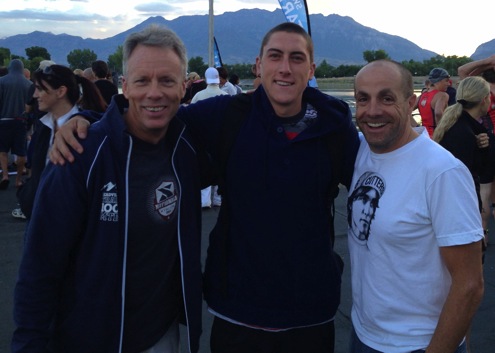
Left to right: Bry, Vic, Fatty, the morning before the race.
The Swim
We got to the Utah Lake marina — from which all three legs of the race would start — at about 6:30. We formed a very carefully-thought-out team strategy: Everyone go at their absolute, utter limit. We knew that if we each had an incredible day, we had a shot at finishing in under four hours.
Meanwhile, The Hammer was having a blast, fussing over and prepping The Swimmer for her race.
Here, The Hammer is making sure every square inch of The Swimmer’s skin is covered in BodyGlide.
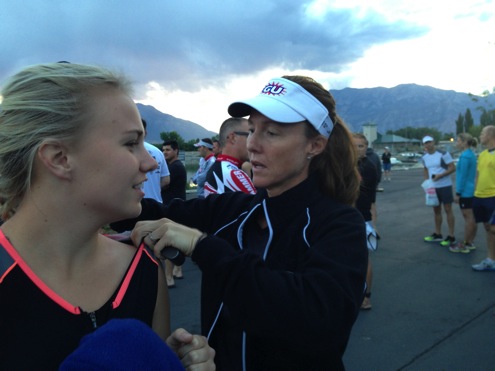
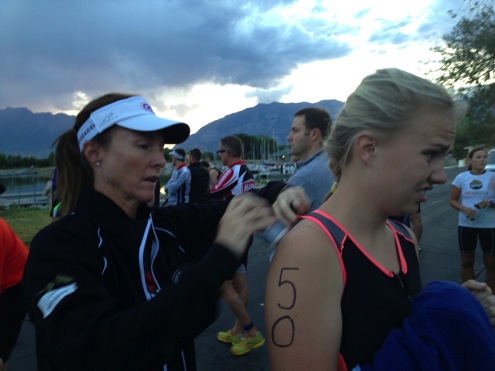
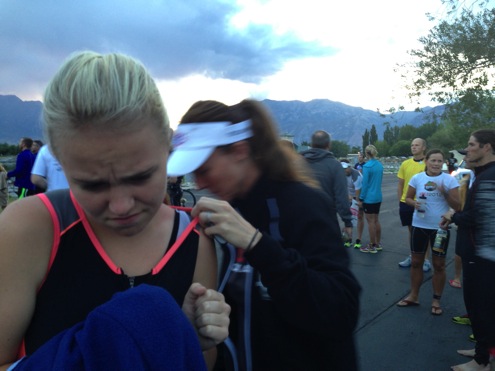
As you can see, The Swimmer was really enjoying herself.
Then she was ready to go:
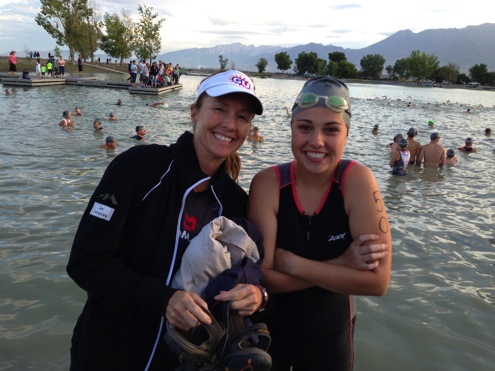
The waves for the beginning of the swim started. Since The Swimmer was a woman under the age of 34, though, she had a twelve minute wait before she took off.
Then we had another four minute wait ’til Bry went — relays were the final wave to leave before the non-competitive wetsuit wave left.
Which meant that my team didn’t start until sixteen minutes after the pros and elites. Which suited me just fine, because that meant I was almost guaranteed to not run out of carrots.
After Bry’s wave started, I found an outhouse, pooped, and changed into my riding clothes, then hung around in the transition area near my seventeen year old boy, who had gotten up early to come to the race and provide moral support to both The Swimmer and me.

He loves being photographed. Obviously.
If there was ever any question about whether 2.5 Grumpy Old Men was taking this race seriously, it ended as Bry came charging out of the water at an absolute dead sprint.
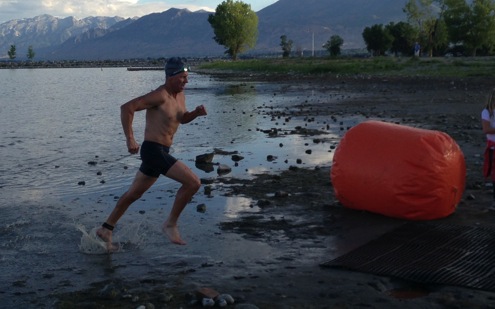
Bry had just done the 1.4-mile swim (longer than the 1.2 it was supposed to be) in 34:24 — making him the fourth-fastest swimmer overall in the race; the only three people who were faster than Bry were all men in the Pro / Elite category.
Our secret plan — of winning not just the relay category, but of having the fastest overall time of the day — was looking downright possible.
Bry sprinted the entirety of the longish run back to the transition area, then stopped, doubled over, while Vic moved the timing chip from Bry’s ankle over to mine.
Looking at me — and I’m incredibly grateful there are no pictures of me here — you could see that I was absolutely happy to sacrifice personal dignity for speed. I had my Shiv set up with water in the in-frame fuelselage (no water bottles to give me increased drag), a skinsuit and time trial helmet on, and my legs and arms — yes, arms — freshly shaven.
But we’ll get back to me in a minute.
Just a few minutes after Bry came charging in, The Swimmer came running in, having just given a serious demonstration as to how she got her nickname: This seventeen-year-old girl had just clocked the fourth-fastest time in the swim of any woman in the race. Yes, including all women in the Pro / Elite category.
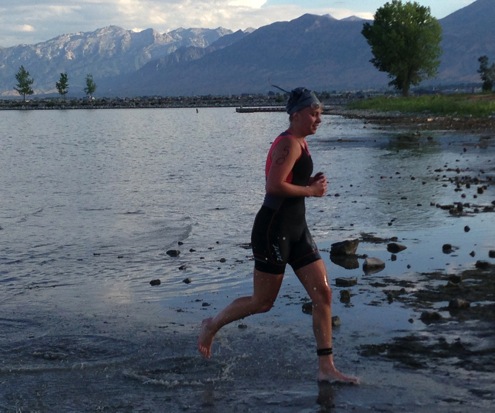
The Swimmer made a quick transition and headed out on what would be the longest ride of her life (remember, she had only ridden 50 miles once before, and this is a 56-mile course).
The Ride
In 2012, I had done this ride in 2:19:47. This year, I hoped to do considerably better.
And so I kept in mind how hard Bry had gone, taking this race seriously. And I kept my effort right on the threshold of blowing up. I know where that point is; I can feel it happening when it starts. And I’ve learned how to back off just enough that I don’t crack, then hold that speed for a few seconds, and then start ramping up again.
And I started passing people.
I’d see someone, and I’d reel them in, and then I’d be past them. Sometimes I’d say, “Hey.” Mostly not though. I just wanted to attack, catch, and demolish anyone I could see.
I didn’t think in words very often. But I do remember thinking to myself, “This is what bloodlust must feel like.”
I was hurting so bad, but I wanted it to hurt even more. I hated it and loved it.
A full-on total-effort TT is a beautiful, purifying experience. (Or at least, that’s how I remember it now.)
Before I got even halfway to the turnaround of this out-and-back course, I had stopped seeing people in front of me very often.
Then I saw the first racer come by me in the opposite direction. I started counting as I got to the turnaround point.
I got to twelve, which dropped to ten within a minute of the turnaround.
And then nine, and then eight.
With twenty-two miles left to go, I was in a non-adjusted ninth place. And I knew that every single one of those eight people ahead of me had at least a ten-minute head start on me.
I looked up and saw The Swimmer. I got a huge smile, feeling so happy that she was doing so well. She was almost to the turnaround.
I caught one more. I had moved us to what was — worst-case scenario — eighth place.
I focused on the road, watching it carefully. The road was in terrible condition, with lots of gravel, serious cracks and potholes, and numerous tight corners, many of which were in bad condition.
“This road is going to end someone’s race in a really bad way,” I thought. And I could see I was at least partially right already — I lost count of how many people I had seen on the side of the road, working on flats.
Then I saw something I’m still trying to work out. I saw a racer coming in the opposite direction of me. Just before I got to him, he flipped a U-turn and continued in the direction I was riding. Was he giving up? Cutting off a third of the course and cheating? Not even in the race?
I had no idea. I passed him, failing to read his number, and kept going.
I didn’t see another rider in the final fifteen miles of the ride course. It was just me and the course marshals and the road markings.
I am very pleased to say, by the way, that I did not make a single wrong turn this year. So, yay me!
I rolled into the marina, where I was blocked by a car — stopped — in the middle of the race course. Luckily, there was another road lane open, so I managed to swerve around the car, heard — but didn’t see — The Hammer cheering for me, and then I was in the transition area.
Vic swapped the timing chip anklet onto his ankle, and was gone at what would be a sprint for me, but what for him was his normal running pace.
I had just done my ride in 2:07:28, which means I had averaged 25.1mph for 53.3 miles (which is a few miles too short to be an actual half-iron distance race, but whatever). Eventually, we’d find out that only one person had been faster on the bike that day: Rory Duckworth, with a blisteringly fast time of 2:03:14 — on average, a whole mile per hour faster than me.
Wow.
Endings, Some Happier Than Others
As I walked my bike back to my truck, where I’d change and then go cheer on Vic as he ran by at impossible speeds, The Hammer had some bad news for me.
“The Swimmer just called,” she said. “She’s crashed.”
I immediately thought of all the gravel and potholes and bad road and corners and the fact that The Swimmer has ridden a road bike around five times in her life.
Evidently, The Swimmer had hit a pothole, lost control, and gone down hard on her left side.
“The handlebar is broken and I’m really scraped up,” she said (which makes two handlebars she’s broken in four months, versus the zero I’ve broken in twenty years).
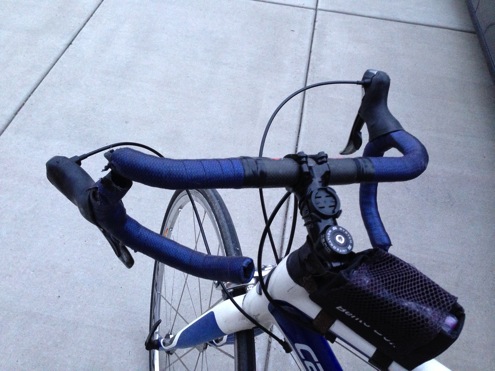
Yup, that’s broken (but The Hammer didn’t realize it was this broken during the call).
“But I still want to finish the race,” The Swimmer said, and the conversation ended there. The Hammer went to wait for The Swimmer at the transition area, and I went to cheer for Vic.
Vic flew by in moments, overtaking people by the dozens.
“I’ll see you at the finish line!” I shouted, and then walked back to the transition area to hang around with The Hammer and wait for The Swimmer to get there and see if she was well enough to finish her race.
But she was already back. The policeman and medic who had been close by when The Swimmer crashed had agreed: her bike was not safe to ride (I agree completely). Also, judging from the state of her helmet, The Swimmer had taken a good hard hit on the head.
And so they had given her a ride back. It doesn’t matter how tough you are (and The Swimmer is clearly just like her mom, toughness-wise); if the officials say you’re out…well, you’re out.
So everyone headed home, leaving me to stick around to watch Vic come in.
I didn’t have to wait long.
Only three people had crossed the line when Vic came charging in, running what I would have called way too fast for him to have just done a marathon. I joined him, thinking we’d cross the line together.
But I couldn’t hang. Nope, not even for fifty feet. By the time he crossed the finish line, Vic was twenty feet ahead of me.
His split was 1:18:54, making him the second-fastest runner of the day. The only person to outrun Vic was BJ Christensen, the overall winner of the individual event. And that was only by 38 seconds.
More importantly, Team 2.5 Grumpy Old Men had just completed this race in 4:01, making us the fastest time not just of the relay division, but of the entire race. With six minutes to spare.
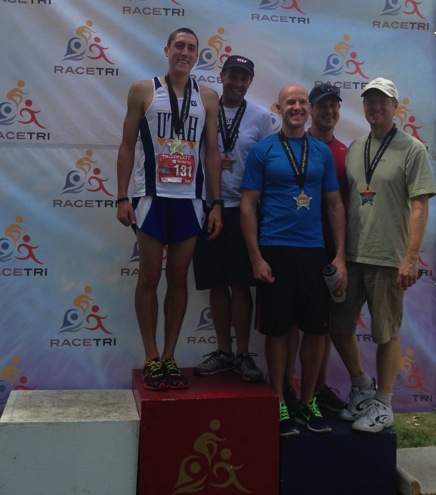
Here we are with the third-place team, Team Darkhorse. Bry had to get home to other stuff, and the second place team didn’t stick around for the awards ceremony.
Not bad. Not bad at all.
Back Home
With the race and awards ceremony out of the way, I came home to see how bad The Swimmer looked.

Ow. That looks bad.
And she’s got road rash pretty much all up and down her left arm, hip, and leg, along with cuts and bruising on the inside of her right leg, from being still clipped in when she went down.
And a very sore neck.
And a concussion.
And so I asked her, not waiting for the memory of the fall to fade, because that’s not my way, “Are you going to try again next year?”
“Of course I am,” she replied.
Which is exactly what I hoped she’d say.
Comments (48)
08.16.2013 | 8:11 am
A Note from Fatty: I will be traveling for work all next week, and won’t have time to write this blog. I’ll be back August 26. ‘Til then, just remember: You’re my very favorite reader of all time.
The Future
I remember Charlie Brown
Talking about post-Christmas letdown
Or maybe it wasn’t Charlie Brown
It could have been someone else
Whatever
It’s beside the point
Anyway
I never really
Understood
What that was all about
Even as a child
When Christmas was over
I was glad
Because Christmas trees make me
Acutely aware
Of my utter lack of artistic ability
Witnessed by
The way my sisters
Would take down the ornaments
I had put up
And put them in new
More artful
Locations
But now
I think I understand
What Charlie Brown
(or whomever)
Was getting at
Because the Leadville 100 is behind me
And the dieting
And the training
And the obsessing
That I poured into this objective
Suddenly seem pointless
I am at loose ends
But lo!
I am just kidding!
Because that race
Is in reality
A somewhat short race
Comparatively speaking
Compared, that is
to the two
– Yes, two –
Much bigger
And longer
And quite frankly
Scarier races
I am planning to do
In the near future
Salt to Saint!
A 420-mile relay
From Salt Lake City
To Saint George
Which I am not
– alas –
Doing as a relay
Instead I shall ride it
Solo
As if to prove a point
On September 20
But I have not revealed all
25 Hours in Frog Hollow!
An extraordinary race
On an extraordinary MTB loop
Near Saint George
Over the time change
Hence the name
Which is somewhat gimmicky
But who am I to judge gimmicks
Because the race is awesome
And I am registered
To race it solo
On a singlespeed
November 2
But I have still not revealed all
Not even close, really
Thank you.
Comments (51)
08.14.2013 | 6:40 am
The Hammer and I went out for a ride yesterday evening. Our first since finishing the Leadville 100 last Saturday. As we rode up Hog Hollow — our gateway to Corner Canyon — The Hammer remarked, “I didn’t have any urge to cry as I crossed the finish line this year.”
“Huh,” I replied, to show that I was listening, but knew that this wasn’t a stand-alone thought (I am able to convey a remarkable amount of information by simply saying “huh.”).
“Not in Twin Lakes, either,” she continued. “Not anywhere during the race.”
I told her I thought this was interesting, and asked if she had thought about why she hadn’t.
“When I first started doing this race,” she said, “I didn’t know if I could finish it. Discovering that I could make myself keep going, no matter what, changed how I saw myself.”
“And now,” I said, understanding, “it’s been quite a while since there’s been any question about whether you’ll finish. You’ve answered that question definitively. In the absence of a busted frame or an act of God, you’re going to finish this race with plenty of time to spare.”
“Yeah,” said The Hammer. “And the question of ‘When will I…’ isn’t as meaningful as ‘Will I at all?’”
I think The Hammer’s right (this is in fact, my default stance on all matters related to The Hammer). You learn more about yourself by completing than by competing. And that makes for a truly meaningful experience. Which is why Doug Bohl’s story — where he literally collapses at the finish — is special. Or why Chris’s story — where (forgive me for the spoiler) he finishes about half an hour too late to get the buckle — is inspiring.
Contrast those finishes with this:
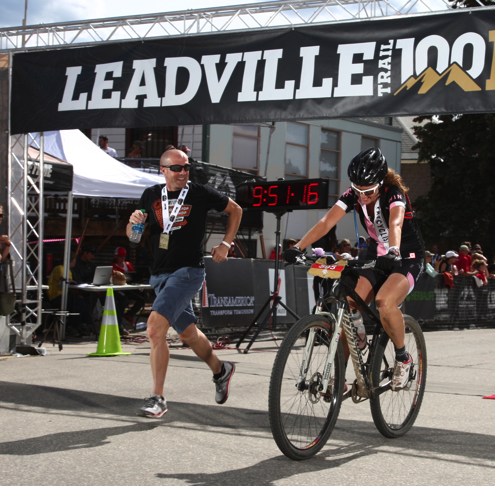
Photo courtesy of Zazoosh Media
That’s The Hammer, crossing the finish line as she’s just set a new women’s singlespeed record at Leadville — by quite a large margin. And that’s me, about an 1.5 hours after I’d finished the race, running the last 50 yards alongside her.
Is it awesome? Yes. Absolutely. Look how happy we are:
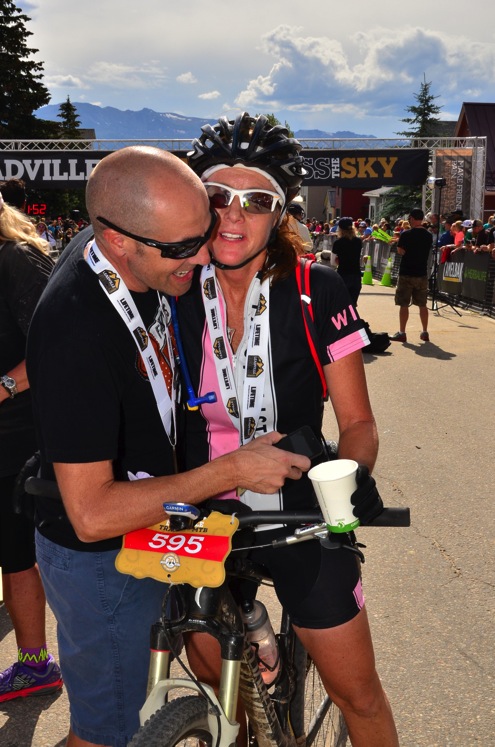
Photo courtesy of Zazoosh Media
But our finishes were more of a confirmation of the value of a lot of years of hard work. A demonstration that you can make significant — albeit incremental — gains if you persist in doing what you love.
If there’s an “aha” moment in that, it’s a lot more subtle than the all-at-once discovery a lot of us have had when we finished our first big race or event…that moment where you discover that the universe of things too hard for you to do is a lot smaller than you thought.
The Obligation of the Experienced
I found myself thinking about the conversation The Hammer and I had. I wondered, for races like Leadville, once you’ve had your breakthrough moment, should you move on? Is there any point in continuing to do the race?
I think the answer’s “yes,” at least for me, for a number of reasons.
First, because I still love doing the race. Not every experience needs to turn your world upside-down. I still feel a huge sense of accomplishment in finishing the race, and I do in fact love that, in my (let’s face it) late forties I am faster and fitter than I have ever been in my life.
This is not the expression of someone who has just phoned in his race:
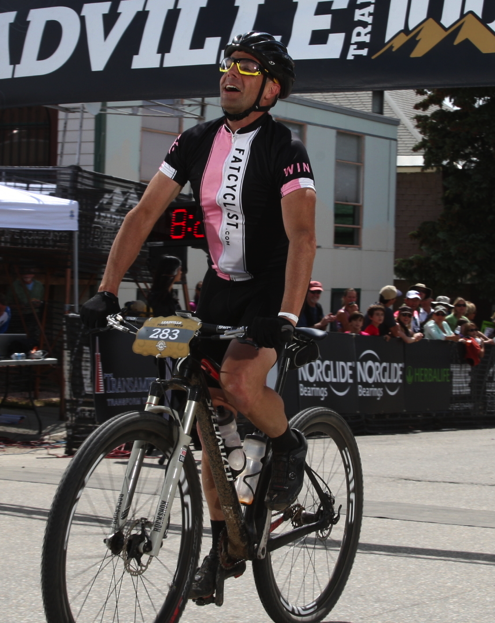
Photo courtesy of Zazoosh Media
But that’s not the only reason. I think that people who have become the old hands are crucial to a race because we become the guardians of that race’s culture.
We’re the ones who know that it’s a tradition for the people who are climbing to the top of the Columbine Mine to cheer for those who are descending. And that it’s the obligation of those descending to encourage those who are pushing their way up.
We’re the ones who know that — even though you’re completely wiped out from your own efforts — the most amazing thing you can do after finishing your race is come to the finish line and scream your heart out for those who are still on the course and are still working just as hard (or harder) than you were.
We’re the ones who know that littering during the race is completely unacceptable.
We’re the ones who know that everyone gets a little bit addle-headed by the altitude and exhaustion and might make a riding mistake, and that everyone’s in this together, and that accidents happen.
We’re the ones who need to pass down the culture of the race by example, and by making sure that everyone we talk with knows that a lot of the best parts of a race don’t have much to do with racing.
At the same time we old-schoolers need to preserve the best aspects of a race, we need to let it evolve without getting cranky about how “it used to be so much better when….” Things change. And if the change is seriously bad, we need to talk to the race organizers — as opposed to spoiling the event for others who don’t have the same frame of reference.
Up Next?
So we’re comfortable with being the old farts sitting in our rocking chairs and acting all grandparently in the Leadville 100 race. Fine.
But we’ve been thinking: we don’t want to just keep doing what we’ve done. We want to see what it would be like to do something different. Something that pushes us outside what I guess we’ll have to call our “comfort zone,” although I wouldn’t go so far as to say that I’m particularly comfortable at any point during the Leadville 100.
We’ve got a couple things in mind. We’ll tell you about them soon.
Once we’ve done them.
Comments (58)
08.13.2013 | 6:20 am
Over the course of twenty years, how many people have ridden in the Leadville 100? And how many miles have they ridden, preparing for this race? How many pedal strokes have been devoted to achieving a goal?
I have no idea what the answer is. But it’s a beautiful thought: so many people, working so hard and long, to accomplish something that matters to them.
And with very few exceptions — the people chasing a podium position — we’re all working together, just trying to beat a common enemy: the clock.
When racing the Leadville 100, I often look around and marvel at the person riding beside me. Because I know that this complete stranger, right there, has somehow gotten to the exact same point as I have, at the exact same time, in the exact same race. Right at that moment, is there anyone in the world I have more in common with? I wonder if that person is experiencing the same strange brew of emotions and feelings I am: excitement, intensity, exhaustion, anxiety, joy, and a deep, deep desire to know what the very near future will bring (a bonk? a crash? a personal best? all of the above?)
But I don’t ask, because when I’m racing, I have an extremely hard time forming words, and sentences are out of the question. Racing ain’t no time for jibber-jabber. I’ll translate what I felt in my heart and gut during the race into words later.
So — if I am able — after I finish the race, I love to clean up and head back to the finish line, sitting in the bleachers, eating nachos and ice cream (there’s a store less than fifty feet away from the finish line that sells both, which is good, because after the race there’s no way I could walk more than that distance), and watching people as they cross the line. So many people. Every one of them with a story I would love to hear.
But it has to be good enough, sometimes, to just see it on their faces.
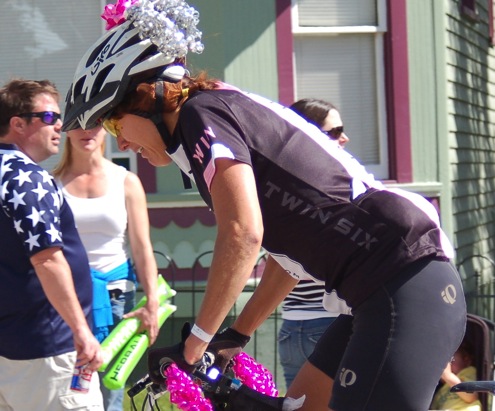
My friend Jilene gets emotional as she approaches the finish line, having just given everything she had (and more) to set a personal best of 9:23. Photo courtesy Brenda Conant.
I’m lucky; I’ve been doing this race and this blog long enough that quite a few people feel like they can tell me their stories. In fact, one of my favorite things about the Leadville 100 this year was how many people came up to me and told me that my race reports had been instrumental in their deciding to do this race, or had been useful in helping them visualize the course, or had been helpful in learning what to do — and what not to do — when racing.
A bunch of us took photos together:
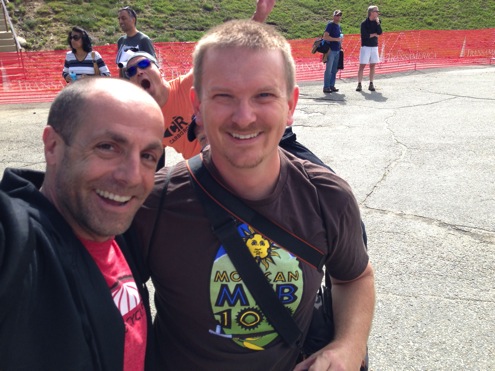
I love the way Kenny’s photobombing this shot.
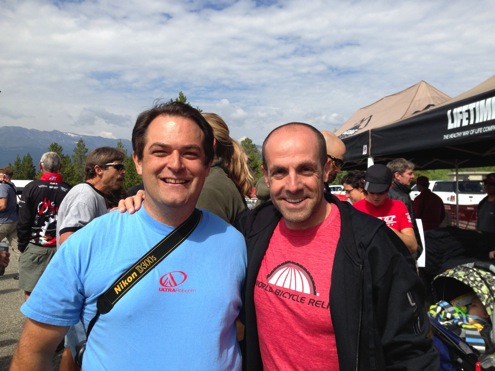
UltraRob and me.
And I got to see — and hear — little snippets of their own stories. Sometimes before, sometimes during, and sometimes after the race. I heard too many to recount all of them, but here are a few things I remember.
Doug Bohl
Doug is a frequent commenter on this blog, so a lot of you already know him, at least a little. And he is doing a fantastic job of writing up his own Leadville Trail 100 experience on his blog.
But one of the standout moments of the whole weekend for me was when he and his family had The Hammer and me over for lunch at their cabin last Thursday (a couple days before the race) and we spent almost the whole time talking about the upcoming race.
Through Doug, I got to experience the newness, anxiety, and obsessive preparedness that only a first-time LT100 racer can know.
We checked out each other’s bikes. I looked at him and declared, based on nothing more than his complete lack of paunch, that he would finish half an hour faster than he thought he would.
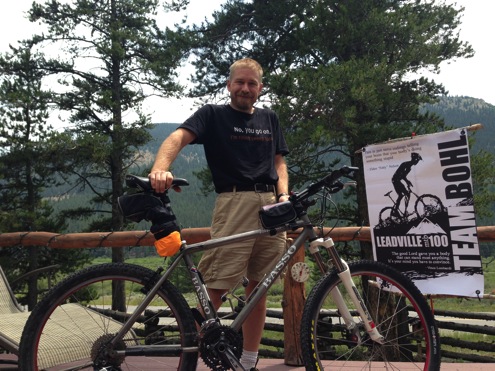
I also bit my tongue, and refrained from saying anything about a couple things he said he had done to prepare for, or was planning on doing, during the race. Hey, what did I know? Stuff that hadn’t worked for me might just be because of me.
And later I’d be glad I kept those things to myself, because as near as I can tell, Doug had a banner day. One thing’s for certain: his first LT100 finish time was faster than my first LT100 finish time.
Rebecca Rusch
I’ve been a fan of Rebecca Rusch for years; she’s a LT100 icon as well as an amazing bike pro and advocate for many of the same causes I care about. We’ve also become friends over the past year or so. So you shouldn’t be too shocked to know that when I got to Leadville, I sent her a text message asking if she’d like me to lob any softball questions her way to give her a chance to promote her sponsors on Twitter.
But I was concerned when she replied that her head wasn’t in the race, and she’d explain later.
The Hammer and I met her later that morning, where she told us that a good friend of hers had been killed earlier that week, run over by a truck while riding her bike.
Rebecca almost didn’t come to Leadville. She didn’t want to race; her heart wasn’t in it.
But then, instead of bailing, she changed her focus. She spent time with people. She listened to their stories, and gave advice when asked. She raced with the intensity she was able to give, in spite of this tragedy. Which was still fast enough for a blisteringly-fast third place.
And then stayed at the finish line for hours and hours, congratulating people as they crossed the finish line.
Linda
Linda has been working at the Delaware Hotel for as long as I’ve been racing the Leadville 100. We see each other only once per year, but she knows the names of all my kids, knows Lisa, and knows how I did at the race the previous year.
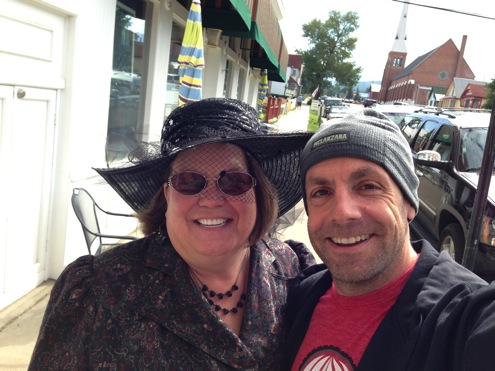
And I’m pretty sure I’m not the only one who Linda treats like a favorite nephew.
Matt Beaudin
I have to admit: I’m a Matthew Beaudin fanboy. He’s a writer for Velo, and he’s exactly the writer I wish I were. He writes smart, clear, and direct. I knew he was racing the Leadville 100 this year, so kept trying to find him.
Until the race itself, I kept failing.
Then, half a mile up the Columbine climb — right about the point when being on a singlespeed stops being a liability and suddenly becomes an outrageous advantage — I came across a guy in full Velonews kit. “Are you Matthew Beaudin?” I asked.
“Yeah,” he said, and then we talked about the climb we were on, and how it was really not as bad as the Powerline — the real crux of the race.
“I’ll be walking a lot of that,” I said.
“I hope to ride it all,” Matthew replied.
“Ha!” I laughed. I didn’t mean to, but I couldn’t help it. Nobody rides all of the Powerline.
Then — somehow — we wound up at the base of the Powerline at the same moment. “OK, let’s see you climb this thing without dabbing,” I said.
“The plot’s thickened, Fatty,” Matthew replied. “My left shoe’s cleat is loose and I can’t clip out. Now I have to climb the whole thing.”
And he proceeded to do just that, at least until another rider couldn’t get out of his way in time, at which point Matthew had to take off his shoe, leaving it clipped into his pedal, and march along with the rest of us. Had I the energy, I would have begun singing “Diddle Diddle Dumpling” right then. And I can’t even tell you how desperately I wished for a camera.
That said, as soon as he got to a place where he could restart, Matthew got back into his shoe and continued riding, disappearing up the hill as I continued to march.
Be sure to read Matthew’s own impressions of the Leadville 100 here.
When you get right down to it, the culture of a race is the people in it — the racers (both the pro and the ordinary), and the memories they bring away from it. The stories they have to tell. And that’s what makes the Leadville 100 — and many other races — great.
Comments (31)
« Previous Page — « Previous Entries Next Entries » — Next Page »




















